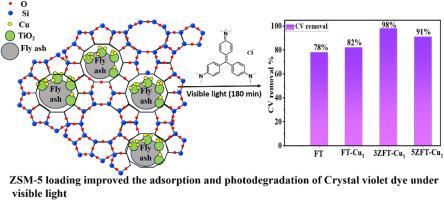负载zsm -5的粉煤灰- tio2 - cu杂化复合材料在可见光-太阳照射下对结晶紫的吸附和光催化活性的提高
IF 4.7
3区 材料科学
Q1 CHEMISTRY, APPLIED
引用次数: 0
摘要
本研究合成了Cu光沉积粉煤灰- tio2 (FT-Cu1)复合材料。用ZSM-5沸石的浓度分别为1 wt%、3 wt%和5 wt%进行改性,分别命名为1ZFT-Cu1、3ZFT-Cu1和5ZFT-Cu1,以去除结晶紫染料。实验考察了ZFT-Cu1复合材料(1、3、5 wt% ZSM-5)在可见光和光催化下对结晶紫的吸附和降解性能。采用UV-VIS DRS, FE-SEM, XRD, FTIR和BET表面积分析进行了结构和光学表征。结果表明,将ZSM-5沸石掺入FT-Cu1复合材料中,提高了结晶度,减少了团聚,改善了可见光吸收。改性后的复合材料中,3ZFT-Cu1复合材料(ZSM-5负载3 wt%)的光催化活性最高,在可见光下对CV染料(Qe = 27 mg/g)的去除率为98%,在太阳光下对CV染料(Qe = 20.24 mg/g)的去除率为95%,催化剂剂量为5 mg/L,染料浓度为5 mg/L,接触时间为180 min, pH为9。吸附数据很好地符合Freundlich等温线,证实了多层覆盖,动力学符合伪一阶模型。效率的提高是由于Cu掺杂、多孔ZSM-5和粉煤灰载体的协同作用,提高了光吸收和染料吸附。经过5次循环后,3ZFT-Cu1的降解效率保持在84%,具有良好的稳定性和可重复使用性。利用空穴清除剂捕获自由基,确定了CV染料的光分解途径,证实了其在染料废水处理中的可见光活性潜力。本文章由计算机程序翻译,如有差异,请以英文原文为准。

Improved adsorption and photocatalytic activity of ZSM-5-loaded fly ash–TiO2–Cu hybrid composites for crystal violet removal under visible-solar light irradiation
In the present investigation, Cu photo-deposited fly ash–TiO2 (FT-Cu1) composites were synthesized. The prepared composite was modified with 1 wt%, 3 wt%, and 5 wt% of ZSM-5 zeolite and named as 1ZFT-Cu1, 3ZFT-Cu1, and 5ZFT-Cu1, respectively, for the removal of crystal violet dye. Experiments were conducted to evaluate the performance of the ZFT-Cu1 composites (1, 3, and 5 wt% ZSM-5 loadings) for the adsorption and photocatalytic degradation of crystal violet under visible and solar light. Structural and optical characterizations were performed using UV–VIS DRS, FE-SEM, XRD, FTIR, and BET surface area analysis. The results demonstrated enhanced crystallinity, decreased agglomeration, and improved visible-light absorption due to incorporation of ZSM-5 zeolite into the FT-Cu1 composite. Among the modified composites, the 3ZFT-Cu1 composite (3 wt% ZSM-5 loading) showed the highest photocatalytic activity, achieving 98 % removal of CV dye (Qe = 27 mg/g) under visible light and 95 % removal (Qe = 20.24 mg/g) under solar light at catalyst dose of 5 mg, dye concentration of 5 mg/L, contact time of 180 min, and pH 9. The adsorption data were well-fitted to Freundlich isotherms confirming multilayer coverage, and the kinetics adhered to a pseudo-first-order model. The enhanced efficiency is attributed to the synergistic effects of Cu doping, porous ZSM-5, and fly ash support, which improved light absorption and dye adsorption. Furthermore, 3ZFT-Cu1 retained 84 % degradation efficiency after five cycles, confirming good stability and reusability. The photodecomposition pathway of CV dye was identified through free radical trapping using hole scavengers, confirming its visible-light-active potential for dye-based wastewater treatment.
求助全文
通过发布文献求助,成功后即可免费获取论文全文。
去求助
来源期刊

Microporous and Mesoporous Materials
化学-材料科学:综合
CiteScore
10.70
自引率
5.80%
发文量
649
审稿时长
26 days
期刊介绍:
Microporous and Mesoporous Materials covers novel and significant aspects of porous solids classified as either microporous (pore size up to 2 nm) or mesoporous (pore size 2 to 50 nm). The porosity should have a specific impact on the material properties or application. Typical examples are zeolites and zeolite-like materials, pillared materials, clathrasils and clathrates, carbon molecular sieves, ordered mesoporous materials, organic/inorganic porous hybrid materials, or porous metal oxides. Both natural and synthetic porous materials are within the scope of the journal.
Topics which are particularly of interest include:
All aspects of natural microporous and mesoporous solids
The synthesis of crystalline or amorphous porous materials
The physico-chemical characterization of microporous and mesoporous solids, especially spectroscopic and microscopic
The modification of microporous and mesoporous solids, for example by ion exchange or solid-state reactions
All topics related to diffusion of mobile species in the pores of microporous and mesoporous materials
Adsorption (and other separation techniques) using microporous or mesoporous adsorbents
Catalysis by microporous and mesoporous materials
Host/guest interactions
Theoretical chemistry and modelling of host/guest interactions
All topics related to the application of microporous and mesoporous materials in industrial catalysis, separation technology, environmental protection, electrochemistry, membranes, sensors, optical devices, etc.
 求助内容:
求助内容: 应助结果提醒方式:
应助结果提醒方式:


